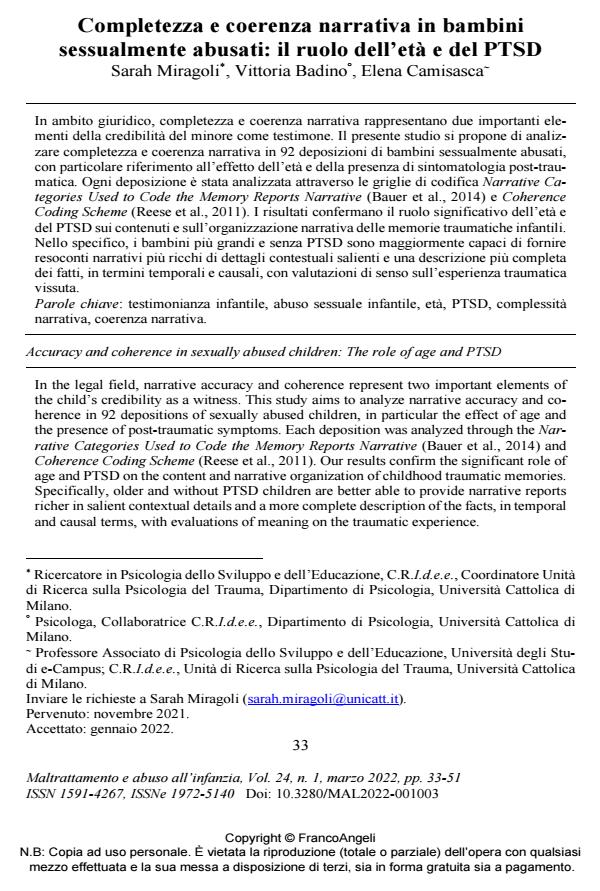Completezza e coerenza narrativa in bambini sessualmente abusati: il ruolo dell’età e del PTSD
Titolo Rivista MALTRATTAMENTO E ABUSO ALL’INFANZIA
Autori/Curatori Sarah Miragoli, Vittoria Badino, Elena Camisasca
Anno di pubblicazione 2022 Fascicolo 2022/1
Lingua Italiano Numero pagine 19 P. 33-51 Dimensione file 214 KB
DOI 10.3280/MAL2022-001003
Il DOI è il codice a barre della proprietà intellettuale: per saperne di più
clicca qui
Qui sotto puoi vedere in anteprima la prima pagina di questo articolo.
Se questo articolo ti interessa, lo puoi acquistare (e scaricare in formato pdf) seguendo le facili indicazioni per acquistare il download credit. Acquista Download Credits per scaricare questo Articolo in formato PDF

FrancoAngeli è membro della Publishers International Linking Association, Inc (PILA)associazione indipendente e non profit per facilitare (attraverso i servizi tecnologici implementati da CrossRef.org) l’accesso degli studiosi ai contenuti digitali nelle pubblicazioni professionali e scientifiche
In ambito giuridico, completezza e coerenza narrativa rappresentano due importanti elementi della credibilità del minore come testimone. Il presente studio si propone di analizzare com-pletezza e coerenza narrativa in 92 deposizioni di bambini sessualmente abusati, con parti-colare riferimento all’effetto dell’età e della presenza di sintomatologia post-traumatica. Ogni deposizione è stata analizzata attraverso le griglie di codifica Narrative Categories Used to Code the Memory Reports Narrative (Bauer et al., 2014) e Coherence Coding Scheme (Reese et al., 2011). I risultati confermano il ruolo significativo dell’età e del PTSD sui contenuti e sull’organizzazione narrativa delle memorie traumatiche infantili. Nello spe-cifico, i bambini più grandi e senza PTSD sono maggiormente capaci di fornire resoconti narrativi più ricchi di dettagli contestuali salienti e una descrizione più completa dei fatti, in termini temporali e causali, con valutazioni di senso sull’esperienza traumatica vissuta.
Parole chiave:testimonianza infantile, abuso sessuale infantile, età, PTSD, complessità nar-rativa, coerenza narrativa.
- Coherence of child maltreatment narratives by emerging adults: How does child maltreatment affect how we share our story? Mariam Fishere, Tilmann Habermas, in Applied Cognitive Psychology /2023 pp.531
DOI: 10.1002/acp.4056 - Le violenze sui minorenni in ambito sportivo: inquadramento del fenomeno, dati di prevalenza e best practices Maria Cristina Verrocchio, in MALTRATTAMENTO E ABUSO ALL'INFANZIA 3/2024 pp.7
DOI: 10.3280/MAL2023-003001
Sarah Miragoli, Vittoria Badino, Elena Camisasca, Completezza e coerenza narrativa in bambini sessualmente abusati: il ruolo dell’età e del PTSD in "MALTRATTAMENTO E ABUSO ALL’INFANZIA" 1/2022, pp 33-51, DOI: 10.3280/MAL2022-001003